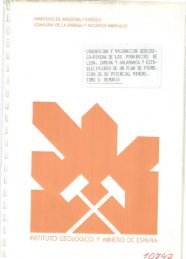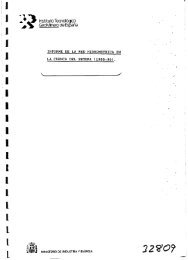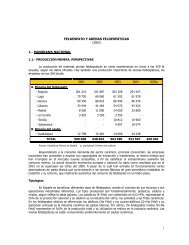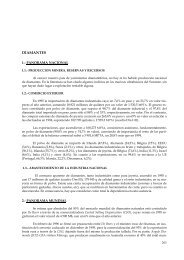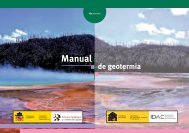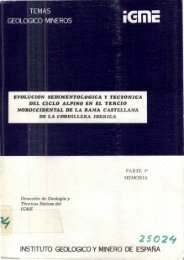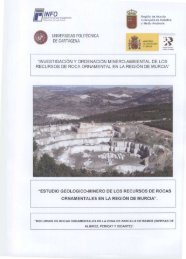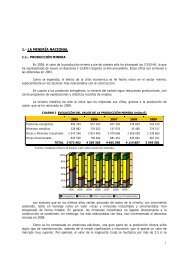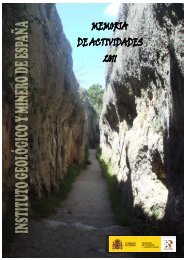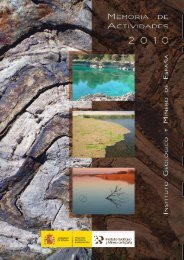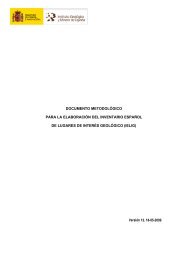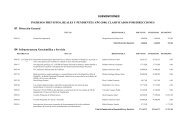6. Rotational kinematics of the Boltaña anticline - Instituto Geológico ...
6. Rotational kinematics of the Boltaña anticline - Instituto Geológico ...
6. Rotational kinematics of the Boltaña anticline - Instituto Geológico ...
You also want an ePaper? Increase the reach of your titles
YUMPU automatically turns print PDFs into web optimized ePapers that Google loves.
<strong>Boltaña</strong> <strong>kinematics</strong> Mochales, 2011<br />
2.1. Introduction<br />
11<br />
2. The Pyrenean Orogen<br />
The North Atlantic opening and <strong>the</strong> subsequent clockwise rotation <strong>of</strong> <strong>the</strong> African plate during<br />
Cretaceous and Tertiary times produced a general compression along <strong>the</strong> Tethys margins. In its<br />
western side, <strong>the</strong> Pyrenees, Iberian Range and <strong>the</strong> Betics-Rift underwent lower shortening related to<br />
this geodynamic process in comparison to eastern areas (Alps, Figure 1). During <strong>the</strong> Alpine orogenic<br />
stage, intraplate compressional stresses controlled basin inversion, crustal thickening and lithospheric<br />
folding. Variably deep crustal roots characterize <strong>the</strong> Alpine orogenic chains (Ziegler and Dèzes,<br />
2006).<br />
According to some reconstructions, four hundred km <strong>of</strong> shortening took place between <strong>the</strong><br />
Iberian and Eurasian plates in <strong>the</strong> Pyrenean domain during <strong>the</strong> opening <strong>of</strong> <strong>the</strong> Bay <strong>of</strong> Biscay (from 118<br />
to 80 M.a., Sibuet et al., 2004). The ECORS seismic reflection pr<strong>of</strong>ile and teleseismic data show <strong>the</strong><br />
presence <strong>of</strong> two distinct slabs dipping to <strong>the</strong> north. The sou<strong>the</strong>rn slab is associated to <strong>the</strong> subduction <strong>of</strong><br />
<strong>the</strong> neo-Tethys Ocean, which was formed from late Jurassic to early Aptian (Figure 2). Coevally,<br />
elongated back arc basins formed along <strong>the</strong> future Pyrenean domain (Sibuet et al., 2004). The nor<strong>the</strong>rn<br />
one, active from 85 M.a. is linked to <strong>the</strong> subduction <strong>of</strong> <strong>the</strong> lower continental crust located south <strong>of</strong> <strong>the</strong><br />
Pyrenean domain. In <strong>the</strong> upper crust, normal faults and <strong>the</strong> north Pyrenean fault became reverse faults<br />
and former arc basins were inverted, originating <strong>the</strong> uplift <strong>of</strong> <strong>the</strong> Pyrenees as a double verging wegde<br />
(Sibuet et al., 2004), figure 2.<br />
By means <strong>of</strong> up-to date kinematic data, based on magnetic anomalies in <strong>the</strong> Atlantic ocean, a<br />
geodinamic model <strong>of</strong> <strong>the</strong> relative motions <strong>of</strong> Africa-Iberia and European plates was proposed (Figure<br />
3, Rosenbaum et al., 2002). Convergence <strong>of</strong> Africa with respect to Europe commenced between 120 to<br />
83 M.a. This motion depended on fluctuations in convergence rates characterised by two periods <strong>of</strong><br />
relatively rapid convergence (Late Cretaceous and Eocene-Oligocene times) alternated with periods <strong>of</strong><br />
relatively slower convergence (during <strong>the</strong> Paleocene and since <strong>the</strong> Early Miocene). Several stages <strong>of</strong><br />
Iberian-Europe plate <strong>kinematics</strong> can be recognised (Figure 3): 1) Left-lateral strike-slip motion in Late<br />
Jurassic-Early Cretaceous; 2) Late Cretaceous convergence; 3) Paleocene quiescence; 4) Short period<br />
<strong>of</strong> right lateral strike-slip motion; 5) Final Eocene-Oligocene convergence (Rosenbaum et al., 2002).



